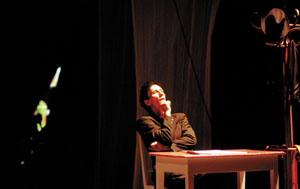This winter, CERN’s LEP pit formed the backdrop for an unusual theatrical performance portraying Paul Dirac’s mathematical discovery of antimatter symmetry.


A hundred metres underground in the pit that houses the Delphi experiment in the world’s largest electron positron collider, LEP at CERN – what better stage for a play about antimatter?
The Delphic Oracleby Geneva’s’Miméscope’ company, in collaboration with CERN, ran for an extended season this winter. Each audience had to be limited to 60 because of the logistics of the LEP pit, and it was carefully divided into smaller groups – electrons, positrons, up quarks – each with its own CERN guide to usher them down, around and back up again.
The Delphic Oracle’saction focused on Paul Dirac’s mathematical discovery of antimatter symmetry, with Markus Schmid playing the role of the scientist gripped by the intensity of original thought and the profound implications of a discovery that went on to change our view of the universe. Such intellectual acrobatics were underlined by Yasmina Krim’s graceful aerial ballet. The light show and backdrops illustrated matter and antimatter at work. At the end of the show, the audience was guided round the Delphi detector – a memorable experience, with even the access lift disguised as a time capsule.
Underground setting, lights and acrobatics apart, the strict scientific focus and the stark table-and-chair props were redolent of Michael Frayn’s play Copenhagen about Niels Bohr and Werner Heisenberg, which all goes to show that physics can make good theatre.
In The Delphic Oracle, Heisenberg did not appear but was the addressee of the letters that Dirac laboriously compiled on stage. Unlike Copenhagen, where Frayn had scrupulously done his homework, physics purists might react to the liberal interpretation of Dirac’s work in The Delphic Oracleand its scientific message. Although Dirac saw the need for symmetry between positive and negative charges in his famous 1928 relativistic treatment of the electron, for several years the proton was identified as the corresponding positive charge. Dirac himself said so in a letter to Naturein October 1930.
Others (notably Oppenheimer and Weyl) began to worry about a particle as heavy as the proton partnering a light electron in a theory that was supposed to be absolutely symmetrical. In May 1931, Dirac grasped the bull by the horns and finally proposed what his equations had been saying all along: “We may call such a [positively charged] particle an anti-electron. We should not expect to find any of them in nature, on account of their rapid rate of recombination with electrons, but if they could be produced experimentally in high vacuum, they would be quite stable and amenable to observation.” These would have been fine words with LEP only a few metres away.
As an introduction to antimatter and as a spectacle, The Delphic Oraclewas memorable, displaying Dirac’s torment at having constructed a theory so perfect that its implications were unthinkable. Dirac suspected that antimatter had to exist, but it took him three tortured years to summon the courage to say so.
Like champagne, antimatter is always stimulating, however it is served.








